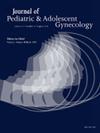17. Bilateral Antenatal Ovarian Torsion with Autoamputation: A Case Report
IF 1.7
4区 医学
Q3 OBSTETRICS & GYNECOLOGY
引用次数: 0
Abstract
Background
While antenatal and neonatal ovarian cysts (OC) typically resolve spontaneously, a minority will result in torsion; when this occurs in utero, there is a higher risk of autoamputation (AA) than in postnatal patients due to delay in intervention. In one case series of 28 patients diagnosed with antenatal ovarian torsion (AOT), 60% had AA of the affected adnexa; however, all of them were unilateral. We present a case of an infant with bilateral AOT resulting in AA.
Case
IRB exempt status was confirmed through our IRB process. Antenatal ultrasound (US) at 33w1d found bilateral OC, with right simple cyst measuring 2 cm and left complex cyst measuring 4 cm. She was born at term via vaginal delivery. US on day of birth showed both OC stable in size and appearance; no normal ovarian tissue visualized. Tumor markers were normal range. She had normal external female genitalia. Repeat US at 1 week of life showed the left complex cyst stable, and the right cyst smaller. Repeat US at 1.5 months demonstrated the same complex cyst stable in size but now located on the right, and the previously seen right cyst resolved; no identifiable ovarian tissue. She was asymptomatic throughout. Due to persistence and complexity, decision was made to proceed with diagnostic laparoscopy, performed at age 3 months. Intraoperatively she was found to have a normal uterus but no identifiable left ovary or fallopian tube (FT), with a 4 cm cystic structure floating on the right but connected to the left infundibulopelvic (IP) ligament by a thin band of tissue, consistent with AA of the left adnexa. This was removed and on pathology there was no viable tissue. The right FT was truncated at the ampulla with no identifiable fimbria, no identifiable right ovary. Superior to the end of the right FT and above the pelvic brim, a 5 mm piece of white tissue was attached to the peritoneum on the side wall, not connected to the right IP or utero-ovarian ligaments, presumed to be what remains of the right adnexa. Given possibility of viable tissue, decision was made to leave this in place; biopsy was not attempted due to concern for damaging the small amount of tissue remaining.
Comments
Antenatal OC are becoming a more common finding with advances in antenatal US imaging, however the incidence of AOT is rare. Most literature reports on postnatal monitoring techniques and leans toward conservative management in most cases. Our case presents a unique situation in which earlier intervention might have outweighed the risk of surgery to potentially preserve ovarian tissue, and would suggest consideration for earlier surgical intervention in cases where bilateral adnexal masses are present.
17. 双侧胎儿卵巢扭转伴自体截肢1例
背景:虽然产前和新生儿卵巢囊肿(OC)通常会自发消退,但少数会导致扭转;当这种情况发生在子宫内时,由于干预延迟,比产后患者有更高的自截肢(AA)风险。在一组28例诊断为产前卵巢扭转(AOT)的患者中,60%患有受影响附件的AA;然而,所有这些都是单方面的。我们提出一个病例的婴儿与双侧AOT导致AA。个案豁免状态通过我们的IRB流程确认。33w1d产前超声(US)发现双侧OC,右侧单纯性囊肿2 cm,左侧复杂囊肿4 cm。她是顺产足月出生的。出生当天的US显示OC大小和外观均稳定;未见正常卵巢组织。肿瘤标志物正常范围。她有正常的女性外生殖器。1周后复查US显示左侧复杂囊肿稳定,右侧囊肿变小。1.5个月复查超声显示相同的复杂囊肿大小稳定,但现在位于右侧,先前看到的右侧囊肿溶解;没有可识别的卵巢组织。她没有任何症状。由于持续性和复杂性,我们决定继续进行诊断性腹腔镜检查,在3个月大时进行。术中发现子宫正常,但未见左侧卵巢或输卵管(FT),右侧有一个4厘米的囊性结构漂浮,但通过薄带组织与左侧骨盆底管(IP)韧带相连,与左侧附件AA一致。这被移除,病理上没有活组织。右侧卵巢在壶腹处截短,未见肠膜,未见右侧卵巢。在右侧腹膜末端上方和盆腔边缘上方,有一块5mm的白色组织附着在腹膜侧壁上,未与右侧IP或子宫卵巢韧带相连,推测为右侧附件的残余。考虑到存活组织的可能性,决定将其保留;由于担心会损坏剩余的少量组织,因此没有进行活检。评论:随着产前超声成像技术的进步,妊娠期卵巢囊肿越来越常见,然而妊娠期卵巢囊肿的发生率却很低。大多数文献报道了产后监测技术,在大多数情况下倾向于保守管理。我们的病例呈现出一种独特的情况,早期干预可能超过手术的风险,以潜在地保护卵巢组织,并建议在双侧附件肿块存在的情况下考虑早期手术干预。
本文章由计算机程序翻译,如有差异,请以英文原文为准。
求助全文
约1分钟内获得全文
求助全文
来源期刊
CiteScore
3.90
自引率
11.10%
发文量
251
审稿时长
57 days
期刊介绍:
Journal of Pediatric and Adolescent Gynecology includes all aspects of clinical and basic science research in pediatric and adolescent gynecology. The Journal draws on expertise from a variety of disciplines including pediatrics, obstetrics and gynecology, reproduction and gynecology, reproductive and pediatric endocrinology, genetics, and molecular biology.
The Journal of Pediatric and Adolescent Gynecology features original studies, review articles, book and literature reviews, letters to the editor, and communications in brief. It is an essential resource for the libraries of OB/GYN specialists, as well as pediatricians and primary care physicians.

 求助内容:
求助内容: 应助结果提醒方式:
应助结果提醒方式:


